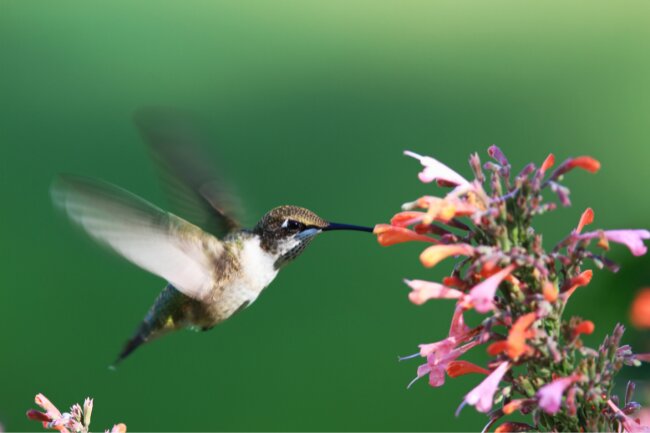Hummingbirds use a wide range of methods to communicate with one another. This can include visual communication, such as using their feathers and flight displays, and vocal calls.
Contents
A quick preview
| Method | Description |
|---|---|
| Songs | Complex vocalizations produced by males to attract mates |
| Calls | Short, sharp vocalizations used for territorial defense |
| Chirps | High-pitched, rapid vocalizations during aggressive encounters |
| Trills | Rapid series of repeated notes, often used during courtship |
| Method | Description |
|---|---|
| Displays | Elaborate aerial displays performed by males to court females |
| Postures | Body positions and movements used to communicate dominance or submission |
| Wing Fluttering | Rapid wing movements used to establish territory or attract mates |
| Tail Spreading | Displaying fanned tail feathers to communicate aggression or dominance |
| Method | Description |
|---|---|
| Feeding Chases | Aggressive flight behaviors to establish dominance or defend food sources |
| Tail Fanning | Rapidly fanning tail feathers to signal territorial boundaries |
| Head Movements | Quick turns or nods of the head to communicate intention or attention |
| Wing Whirring | Producing rapid buzzing sounds with wing movements to communicate aggression |
| Method | Description |
|---|---|
| Plumage Colors | Vibrant and iridescent colors used for courtship displays or signaling |
| Flashing Gorget | Males displaying their colorful throat feathers to attract females |
| Wing Feathers | Flashes of color or patterns during flight displays or territorial encounters |
| Body Postures | Erected or fluffed-up body postures to communicate dominance or submission |
Bird chatter

As humans, we tend to concentrate on speaking when it comes to communication. However, there are in fact, many different ways in which both we and the other animals surrounding us, get our message across. For hummingbirds, here are some of the ways they might communicate with one another.
Colours
Many hummingbird species are well-known for their wonderful iridescent feathers. These coloured feathers are often used as part of courtship displays. The male Costa’s hummingbird, for example, has a violet mask around his face, which he lifts up and displays to the female.
The bright colours can help inform the female how healthy and strong the male is, therefore helping her to decide if he is the one she wishes to mate with. As with many wild bird species, many hummingbird females are much plainer colours. For females, it is often more important to remain hidden when sitting on the nest, than send out colourful signals to their males.
Visual displays

Hummingbirds are amazing fliers, one of the few bird groups able to hover and fly backwards. They use their power of flight to send all kinds of signals, from scaring away rivals to seducing a partner. The wire crested thorntail uses sharply pointed feathers on its tail to woo the female, hovering before her while he waves them from side to side.
Even more stunning is the mating flight of the marvellous spatuletail. The male has two spatula-shaped tail feathers, which he can move independently, so he can waft them in front of the female, creating attractive shapes in the air to demonstrate his prowess.
Sound
Hummingbirds can make sound in a couple of ways. Many species make bird calls or create bird songs, but others can produce sounds with their feathers too. This isn’t unusual in the bird world, with birds such as snipe producing sound by rubbing feathers together.
The Calliope Hummingbird flies up high and then dives down, causing outer tail feathers to vibrate, creating a buzzing sound. He does this display while the female perches nearby, observing his impressive flight skills.
What is a bird song?

Bird song is often seen as one of nature’s wonders. Listening to the joining of the many melodies of the dawn chorus, or just of a solitary bird singing on top of a tree, gives us humans a great deal of pleasure. Yet, for birds, their songs have a very specific use and meaning.
Not all sounds produced by birds are given the grand title of ‘songs’ many birds make sounds but do not sing. Other vocalisations by birds are generally called ‘bird calls’. Bird calls are shorter and less complex than bird songs. They also tend to be more around communicating danger or monitoring each other’s whereabouts.
Bird songs on the other hand are territorial in nature and are usually produced by the males to impress potential mates and warn off rivals. For many species, a good song can take a lot of work to perfect, and a great deal of time and energy.
Does a hummingbird sing?
Hummingbirds are wonderful birds in many ways, but they aren’t the most melodious of creatures. They also aren’t completely mute either, with most species making a range of chittering or squealing sounds. These noises are much shorter and less complex than we would consider necessary for them to be branded as songs.
There are a small number of hummingbirds that do produce a song, Anna’s hummingbird and Costa’s hummingbird are two of the most famous. However, while technically these small colourful birds do use a more complex set of notes to help mark their territory, they still aren’t the most tuneful of warblings, being more a series of chittering noises in the case of Anna’s hummingbird and a high whistle for the Costa’s hummingbird.
Busy talking
Hummingbirds may not be as chatty as some bird species, but that doesn’t mean they don’t have plenty to say. These tiny birds have busy lives, from finding a mate to defending a territory, and even just chirping to their family, they are always busy chatting. For us humans, these conversations may not be as obvious as others, but getting the right message across is vital in the lives of hummingbirds.

